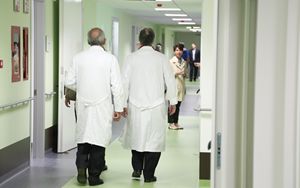(Finance) – In the last year, 1 in 3 Italians (i.e. almost 14 million individuals) has given up one or more medical treatments, a percentage that even reaches 37.5% in the South and on the Islands. Among those who chose not to receive treatment, 64% did so because the waiting times were too long, 60% because of the high cost. This is what emerges fromsurvey commissioned by Facile.it to the mUp Research and Norstat institutes. Among those who renounced exams, visits and operations, the highest frequencies were found for ophthalmology (36%), dermatology (35.6%) and dentistry (35.5%), but there is no shortage of those chose not to seek treatment even in medical areas such as gynecology (25%) or cardiology (26%).
Waiting times – Such high numbers are not surprising if we consider that, as demonstrated by the study, those who in the last year received treatment only through the NHS faced, on average, waiting lists of around 77 days, a value certainly also influenced by the shortage of medical personnel in public facilities. Waiting lists tend to grow to almost double depending on the geographical area and the specialization required. Precisely because of such extended times, 14 million Italians declared that they had turned to a private structure; those who made this choice had to deal, on average, with waiting lists of around 15 days rather than 77 days.
Costs – Many Italians (around 8.3 million) have given up one or more medical treatments in the last year for economic reasons, a figure which is not surprising when analyzing the costs of private healthcare highlighted by the survey; those who received treatment in a paid facility said they spent, on average, 335 euros for each specialist treatment (a value that reaches close to 400 euros in the regions of Central Italy) and which must be multiplied by the number of family members who have had to resort to one or more medical expenses. The average amounts paid by patients were also significantly different depending on the specialist area: they range from 117 euros for blood tests to 144 euros for gynecology; from 210 euros for dermatology to 610 euros for general surgery and 716 euros for dentistry. To cover these costs, 77% of those interviewed used their savings and just 20% were able to take advantage of health insurance; if you continue to read the results of the analysis, you discover that 15% of the sample had to ask for financial support from family members and 5% turned to a bank or finance company.
“Even if in Italy we can count on a free national health system, having health insurance can be a very useful tool especially because, as also highlighted by the survey, to obtain treatment in a short time one is often forced to turn to private – he explains Andrea Ghizzoni, Managing Director of insurance at Facile.it –. The advice, when struggling with the choice of this type of insurance, is to check the information files and carefully evaluate the guaranteed health services and those excluded, taking into consideration, for example, that pre-existing pathologies at the time of subscription are normally not covered by the policy.”
Changing region for treatment – The investigation also highlighted another phenomenon; in the last year over 2.4 million people have had to change region to undergo tests, visits or operations. Although the phenomenon has been detected throughout the country, the areas of Central Italy are the ones where the percentage of those who have changed region for treatment is highest (11.5% compared to the 7.4% recorded at national level). The regions to which people traveled most frequently to receive treatment were Lazio (27%), Lombardy (19%), Emilia-Romagna (15%) and Veneto (11%).
